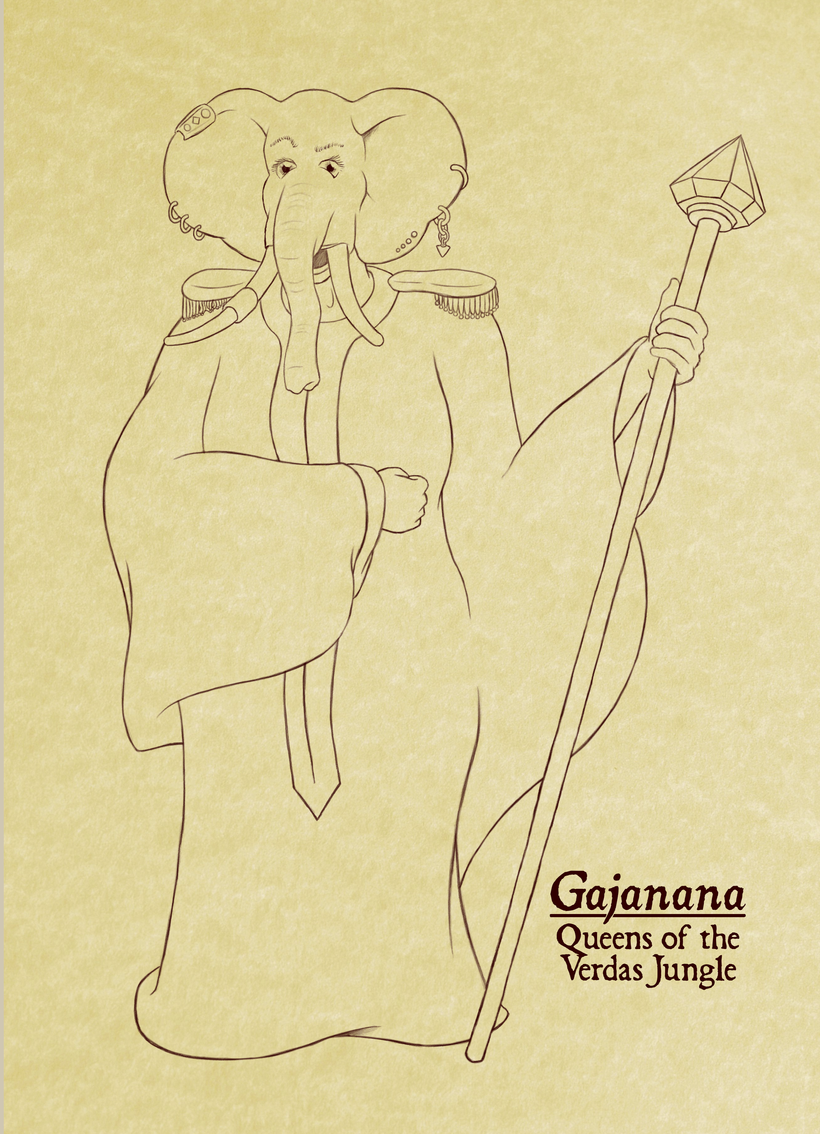Last week’s poll came up with a one vote margin of victory, and so this week we are turning our attention to the largest state in Ipieros, the absolutely (and no pun intended, but gleefully recognized) mammoth Ivory Queendom.
One of my worldbuilding principles has long been There Are No Utopias, which pairs nicely with my natural impulse of revulsion whenever I encounter the “good guy kingdom.” In a game where you’re not (usually) playing the people wearing the crowns, it’s important that the kingdoms, states, and cities are not lilly-white but always have their own embedded problems. This provides setting elements that the player characters can react and respond to—in other words, it’s good fodder for stories. So the Ivory Queendom is grand, cultured, sophisticated… and still not utopia.
Let’s take a look, shall we?
—
Ivory Queendom
The largest state in Verdas by a profound margin, the Ivory Queendom is a constant in the politics of the region. The gajanana queens rule their lands with wisdom, generosity, and abject ruthlessness. Their subjects are protected, cared for, and supported as they work together to make the queendom prosperous and happy. Threats to that happiness and the queen’s power are dealt with decisively.
The Queendom has always possessed ambitions greater than its present territory; its queens have repeatedly proclaimed that they should rule all of Verdas. However, their territory is almost entirely confined to the lands south of the Webiga, from the Delta in the west to the Jolliballum in the east. The Queendom has a few footholds that penetrate into the Delta, the most prominent of which is Cowsport. A handful of Ivory “protectorates” lie on the other side of the Jolliballum; Ivory queens have spent a century slowly absorbing these puppet states into the Queendom.
While its royalty and nobility is and has always been gajanana, the population of the Queendom is as diverse as the rest of Verdas. Goblins, kobolds, cuca, and kappa live as Ivory subjects alongside gajanana commoners. Even the lowest-born gajanana, however, occupies a higher social position that their non-gajanana neighbors. The Queendom has long supported a policy of Gajaprassidha, which elevates gajanana over the other Speaking Peoples, according them respect for greater wisdom and discretion. The ranks of the Queendom’s nobility, officer corps, and magistrates are all restricted to gajanana. This culture of superiority is so profound that the Queendom’s bourgeoisie employ bodysculpting to grey their skin and enlarge their ears.
By long tradition, the Ivory queens are also high priestesses of a national cult which consults with the spirits of the land. The spirits include a number of known genus loci as well as others who reportedly only manifest in private consultations with the queens. The royals ostensibly protect and serve these spirits, although the often proud queens have rarely been servile to them. In practice, the relationship is more an ongoing negotiation and partnership, with both queens and spirits trading information, power, and favors.
Due to these spiritual duties, most queens are accomplished summoners. The Queensguard is composed of erdgeists personally summoned by the queen, ensuring their loyalty. Each erdgeist is drawn from a different part of the Queendom, a feat that would normally be impossible. While the queens maintain the technical secret of summoning erdgeists that can leave the domain of their genus loci, they claim it is a natural extension of their authority and partnership with the land.
The royal court is primarily made up of the queen, her sisters, and their daughters. Minor members include the queen’s aunts and female cousins. Members of the court are often invested with positions of regional authority or positions in the palace such as managing trade or justice. Spouses and sons of the court are occasionally given positions of their own, but are usually assumed to assist with the roles assigned to their wife or mother, respectively.
On the death of the queen, the throne passes to the eldest member of the court, although immediate abdications to the next heir in line are common. Such a choice is frequently made by courtiers who have little talent or interest in communing with the spirits, a significant portion of the role of queen. Those who abdicate are referred to as Aunt Renunciates, and while they remain members of the court, they are never again in line for succession.
When the succession passes from one generation to the next (a youngest sister to her eldest niece), a number of the new queen’s cousins are cut out of the line of succession. Depending on current politics, they might remain in the court as Aunt Renunciates, be dispatched as foreign diplomats, or assigned to dangerous positions far away from the capital. This keeps the line of succession clear, a perpetual obsession of the palace’s internal politics. A disgruntled cast-out cousin has marched on the palace and assumed the throne more than once in the Queendom’s history.
The Ivory Queendom treated peaceably with the Dread Tyrant, agreeing to pay tribute in exchange for escaping reprisals. While this decision kept the Queendom peaceful and safe, it was a grievous blow to the principles of Gajaprassidha. The gajanana queen made herself a subject to an outsider, throwing all their assumed superiority into question. With the fall of the Dread Tyrant, the Ivory queen is eager to put the past behind her, planning a handful of minor wars of conquest to distract attention away from her humiliation.
—
With so many outgoing references in this entry, the poll for next week is nicely varied. We’ve got a little geography, a little ethnography, and a little metaphysics as options. What entry of the Gazetteer would you like to check out next week?
